Steeve Bauras

Small Local Abattoirs #3
Dans le cadre de la 65e édition de Jeune Création1, le photographe Steeve Bauras, né en 1982 à Fort-de-France, a investi au moyen d’un projet inédit l’un des espaces du Centquatre à Paris. Au lieu destiné à loger les chevaux qui, autrefois, occupaient le sous-sol de « l’usine à deuil » de la ville, l’artiste donne le sens d’une boucherie ou, littéralement, d’un « petit abattoir de proximité ».
Making-of
Small Local Abattoirs #3 est le dernier opus en date d’une série de projets entamée en 2013 et présentée depuis à Berlin et à New York2. À la source de l’œuvre : deux clichés. Le premier, en couleur — réalisé lors d’un accrochage collectif aux Beaux-Arts de Paris en 2006 et intitulé U AMAN TANGO (anagramme de Guantanamo) — présente une veste kaki sur un mur orange. Le second, tiré en négatif, un bidon d’essence. Ces images d’objets et / ou images-objets, serties d’un encadrement noir et d’un passe-partout corrodé, sont placées dans un environnement sonore et visuel constitué d’une enceinte, d’une plaque de verre rouge (écrasée et cassée) et d’une projection vidéo réalisée à partir de séquences issues d’Internet captées au moyen d’une caméra Go Pro® sur un écran d’ordinateur. Une maison en flammes, le pivotement obstiné des jambes d’une jeune fille sur un fauteuil rotatif et un concours de plongeon y façonnent un triptyque entrecoupé de rushes subliminaux (dont une photographie de la chapelle du Saint-Sépulcre à Saint-Restitut dans la Drôme) ; canevas en noir et blanc d’une boucle d’environ dix minutes convoquant aussi bien les drames de l’actualité que l’histoire de la première moitié du xxe siècle au travers des thèmes de la folie et du fascisme — l’épreuve de tremplin masculin qui ferme le triptyque est extraite d’un documentaire sur les Jeux Olympiques de 1936 à Berlin.
Vues sous l’angle d’une caméra miniature adaptée à l’immersion et à l’enregistrement d’exploits ou de circonstances extrêmes, les images se contractent et se dilatent. D’inquiétantes silhouettes brûlent et se consument sous l’effet des contrastes. En accompagnement de ces oscillations lumineuses, l’artiste a composé un intense habillage phonique.

Steeve Bauras
Small Local Abattoirs #3, 2014
Photo, acier brut, cadre bois / Photo, raw steel, wooden frame, 50 x 50 cm.
La photographie comme point de départ
Small Local Abattoirs #3 révèle la complexité et la richesse des projets menés par Steeve Bauras depuis une dizaine d’années. Lacérés sur un mur de brique ou tirés en quatre par trois puis collés sur un caisson d’aggloméré, insérés dans un module de skateboard, masqués en partie par un bloc de mousse à bords fluorescents, découpés, imprimés, peints ou occultés, les tirages de Steeve Bauras ne se donnent presque jamais tels quels. Mais le traitement qui leur est réservé a posteriori n’enlève rien au soin apporté à la prise de vue qui demeure, dans la conception multipiste d’une création sensible, à l’origine de toutes les formes exposées.
Car c’est bien autour de la photographie que l’œuvre circule et pense, alternant les durées de captation : temps pulsés et silences, bourdonnements et arrêts. Ce qui se trouve dans et hors de la pratique photographique – le jeu des flous et des nets, les variations de la focale, le soin apporté au détail et à l’ensemble ou l’encadrement des clichés – est à chaque instant interrogé par Small Local Abattoirs #3. Un appareillage optique est étalé sous les yeux du spectateur.
Un plongeur se dessine en fisheye sous un ressaut mural. On suppose au travers de deux œilletons carrés les accessoires d’un attentat : jerricane, treillis militaire. Le bris au sol d’un écran — filtre éphémère ou mare de sang — dit en couleur la frêle condition de tout apparaître. N’étaient les cruelles stridences et le pesant battement de la bande originale créée par l’artiste.
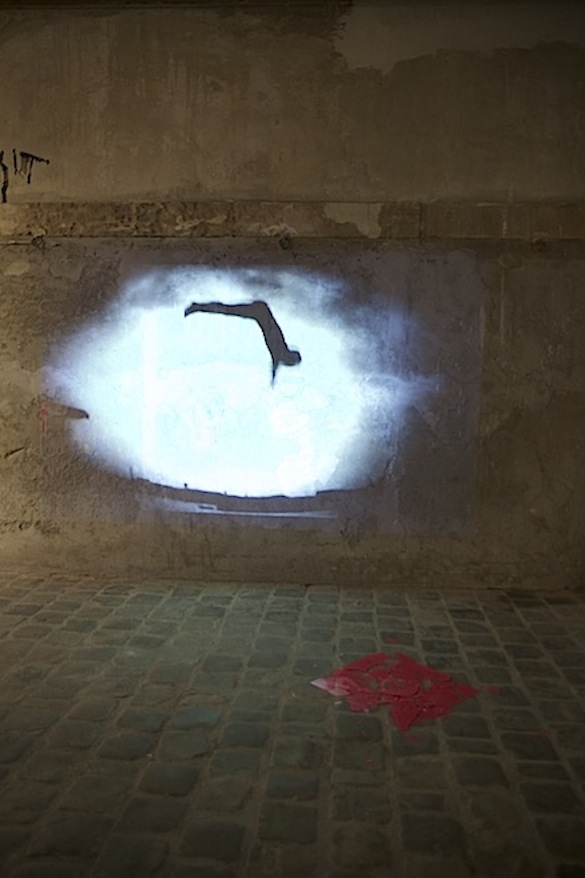
Steeve Bauras
Small Local Abattoirs #3, 2014
Photos, vidéos, son, verre, dimensions variables / Photos, vidos, sound, glass, variable dimensions.
Montage
Volumes et plans participent d’une même méthode de montage. Mises bout à bout, d’un angle à l’autre du lieu d’exposition, les pièces détachées de Small Local Abattoirs #3 forment peu à peu le film de l’œuvre dont la vidéo projetée donne une possible clé d’interprétation en même temps qu’elle baigne les formes d’un halo d’énigme. Le synopsis – une « écriture de lumière » au sens étymologique de la photographie – est fourni par l’artiste et concerne aussi bien sa propre mémoire que celle des lieux. Le projet repose sur un bouclage discret et un solide socle théorique : partir de la photographie pour arriver à la sculpture. Et recevoir de la sculpture une leçon pour la photographie. Tel est l’intervalle dans lequel se situe le propos de Steeve Bauras. Small Local Abattoirs #3 joue sur cet écart – qui est aussi un espace de liberté.
Entre sculpture et expérimentation sonore
La variété d’opérations dont témoigne le dispositif est en lien avec le faire et les processus inhérents à la sculpture et au son. Steeve Bauras, formé à Fort-de-France puis aux Beaux-Arts de Paris dans l’atelier du sculpteur Emmanuel Saulnier, la doit à une fréquentation assidue des déserts urbanistiques de l’Europe, de l’Afrique et de l’Amérique (Berlin, Cracovie, Dakar, Montréal, Santiago du Chili) et à un dialogue constant avec l’underground musical noise.
On trouve dans Small Local Abattoirs #3 les résidus de ces traversées diurnes et nocturnes, à l’instar du bloc de briques noires auquel est sanglé le vidéoprojecteur ou de l’imposante baffle qui, du box occupé dans les écuries du Centquatre, fait un hypogée rock ou un caveau sonore.
Stratégie du coup forcé
Les modalités traditionnelles de la white box, de la cimaise et de l’éclairage sont déjouées. L’alcôve industrielle est une crypte où partout l’image ripe, tranche, brise, déchire et déroute, privilégiant la stratégie du Zugzwang. L’artiste rassemble sous ce titre une série d’œuvres réalisées depuis 2011, titre qui signifie : « coup forcé ». L’idéal aurait été de ne pas jouer, par peur de dégrader sa position, mais il le faut. « Dans mon travail, explique Steeve Bauras, ce mot traduit bien l’état dans lequel je peux me retrouver avant tout nouveau projet, entre l’excitation et l’énorme frayeur. Plus subtilement, les Zugzwänge sont des hypothèses que j’émets autour de la photographie en ce qui concerne ses modalités de monstration et surtout ses faiblesses.3 » Pour exister, la photographie doit littéralement être exposée. Prendre le risque de l’espace. Produire ses propres lumières et ses propres zones d’ombre.
De fait, l’élégance rauque de Small Local Abattoirs #3 détourne la photographie du protocole usuel de sa monstration. Les images se manifestent par à-coups et par intermittence. Elles surgissent, à la manière des clés d’accord d’une guitare électrique ou du visage d’un rocker expérimental s’extrayant de la nuit du plateau, au contact d’un faisceau ou d’un projecteur.
La précision du positionnement des segments, masses, lignes ou surfaces procède d’un marquage sol-mur par touches chromatiques, compacités et réductions, saturations et retranchements. Hypothèses où le coup, joué perdant, est finalement gagné.
Stimmung et climat de lecture
Dans la pénombre des écuries du Centquatre, les éléments qui forment Small Local Abattoirs #3 et vibrent sous les lueurs d’une vidéo hypnotique se donnent à voir au gré des échos angoissants d’une bande-son macabre.
La création d’une atmosphère à la fois lumineuse et acoustique où les objets balisent un terrain laissé en friche – déléguant au spectateur la tâche d’élaborer sa propre narration, d’effectuer sa propre reconstitution des faits plastiques mis en scène – est une des clés de compréhension du dispositif. Lorsqu’on interroge Steeve Bauras sur sa pratique de l’installation, il parle volontiers de Stimmung, de « climat » de lecture ; d’« ambiance » ou encore de résonance.
La notion allemande de Stimmung, qui désigne une expérience émotionnelle où l’imagination s’accorde avec l’entendement, une « acoustique de l’âme » pour les romantiques, a connu au fil du temps des acceptions et des ramifications diverses (en peinture, esthétique, poésie, musique). Elle qualifie toujours une disposition rythmique teintée d’affect qu’on pourrait traduire, puisant dans le vocabulaire de la musique populaire d’origine noire américaine, par groove : la compréhension du flot et de la texture d’un morceau en même temps que la sensation produite par la dynamique de ce morceau.
Pulsation vitale, le groove (ou swing jazzistique) est cette nappe de subjectivité où s’unifient les fragments harmoniques et les sections rythmiques ; « état » indéfinissable où tout est à sa place sans pour autant « subir » le tempo. État de grâce où stases et vitesses s’équilibrent. À chaque œuvre son groove. À chaque lieu son tempo. Le petit abattoir de Steeve Bauras donne l’exacte mesure des écuries du Centquatre. Murs de briques, tirages métalliques et le phasing d’un accompagnement musical parfaitement calibré.
Déphasage
Le phasing [ou déphasage] de la bande-son conditionne l’appréhension du dispositif. Une rumeur lointaine mais persistante est réfléchie par les murs qui fait tantôt songer au mouvement de la double-pédale d’une grosse caisse de batterie. Ce décalage est à entendre comme la possibilité d’entrer dans le groove de l’artiste tout en goûtant la dynamique de l’œuvre ; climat pulsatile de la Stimmung ou affect rythmique.
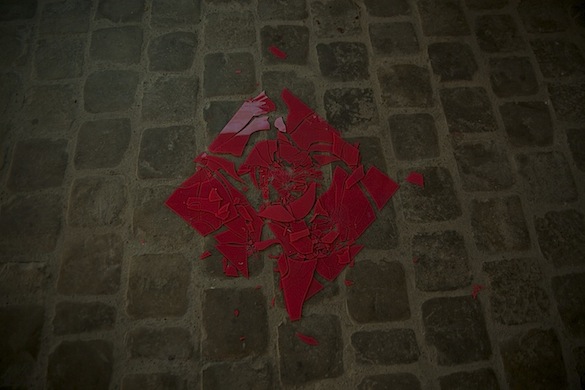
Steeve Bauras
Small Local Abattoirs #3, 2014. (Detail).
Laboratoire ou équarrissoir ?
Avec Small Local Abattoirs s’opère un étrange glissement sémantique de l’écurie à l’abattoir. Haras morbide ou sombre équarrissoir. L’emplacement est envisagé selon toutes ses dimensions historiques et plastiques. Le bâtiment des Pompes funèbres de la Ville de Paris fut édifié en 1873 en lieu et place de l’ancien abattoir de la Commune de la Villette. Steeve Bauras, conscient de ce passé, livre cependant une explication toute personnelle de son titre : « Small Local Abattoirs #3 serait ce laboratoire formel où les choses se détruisent et s’érigent simultanément. Ce serait aussi l’étrange manière que les projets ont, d’exposition en exposition, de s’entretuer, de se neutraliser.4 » Entre les lignes, on retrouve le principe de vagabondage, ou plus exactement de reportage, qui porte Steeve Bauras des banlieues allemandes aux salles de concert noise et lui permet, dans la respiration du voyage, de renouveler son inspiration.
La photographie « de terrain » et l’enquête iconique sont au cœur du carnage feutré qu’est Small Local Abattoirs #3. Le spectateur traverse avec l’artiste un événement dont il éprouve les pressions et les températures, de la chaleur d’un minium à la froideur d’un métal mat. Rien n’est laissé au hasard dans la mise au point de la situation, le processus de création se fondant sur un agencement choral des phénomènes : son, image fixe et vidéo, éléments de sculpture minimaux et percutants échangent en un instantané incisif et mordant.
1 Jeune Création au Centquatre, Paris, du 30 octobre au 2 novembre 2014.
2 Dans le cadre des expositions collectives « Intimités » à SAVVY Contemporary, Berlin-Neukölln, du 9 au 29 juin 2013 et « VOLTA », Grace Exhibition Space, Brooklyn, du 6 au 9 mars 2014.
3 Steeve Bauras, dans un entretien d’avril 2013 pour l’Association internationale des critiques d’art. En ligne sur le site de l’Aica / Caraïbe du Sud : « B-B, Zugzwang n°7, 2013, de Steeve Bauras à Berlin : No Milk Today [Kunsthalle HB55, 3-11 mai 2013]. »
4 Entretien de l’auteur avec Steeve Bauras, Paris, 8 novembre 2014.
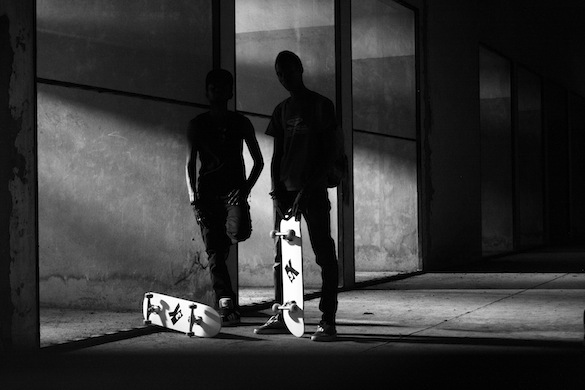
Steeve Bauras, 3K Project, 2013.
Photo, vidéo, son, sculpture / Photo, video, sound, sculpture. Galerie Le Manège, Sénégal.
Steeve Bauras, Small Local Abattoirs #3
As part of the 65th Jeune Création international contemporary art show,1 the photographer Steeve Bauras, born in 1982 in Fort-de-France, Martinique, has occupied one of the areas at Le Centquatre public cultural centre in Paris with a novel project. The artist lends the feeling of a butcher’s shop or, literally, a “small local abattoir” to the place designed to house the horses which formerly occupied the basement of the Paris “mourning factory”.
The Making-of (behind the scenes)
Small Local Abattoirs #3 is the latest work to date in a series of projects embarked upon in 2013, and since shown in Berlin and New York.2 At the source of the work lie two photos. The first, in colour—taken during a group show held at the Paris School of Fine Arts in 2006, and called U AMAN TANGO (an anagram of Guantanamo)—presents a khaki jacket on an orange wall. The second, printed as a negative, shows a petrol can. These images of objects and/or image-objects, set in a black frame and a corroded passe-partout mount, are placed in an acoustic and visual setting formed by a loudspeaker, a sheet of red glass (crushed and broken) and a video projection made using sequences coming from the Internet, captured by means of a Go Pro® camera on a computer screen. A house in flames, the stubborn swivelling of a young girl’s legs on a rotating armchair, and a diving contest make up a triptych interspersed with subliminal rushes (including a photograph of the Chapel of the Holy Sepulchre at Saint-Restitut in the Drôme); a black-and-white framework of a loop lasting for about ten minutes, conjuring up both topical dramas and the history of the first half of the 20th century through themes of madness and fascism—the men’s springboard event which winds up the triptych is taken from a documentary about the 1936 Olympic Games in Berlin.
Seen through the lens of a miniature camera adapted to being underwater and for the recording of extreme feats and circumstances, the images contract and dilate. Disconcerting shapes burn and are consumed by the effect of contrasts. To go with these oscillations of light, the artist has come up with an intense phonic composition.
Photography as a starting point
Small Local Abattoirs #3 reveals the complexity and wealth of the projects which Steeve Bauras has been involved with for the past ten years or so. Whether in tatters on a brick wall or presented as 32 sheet prints, then glued onto a chipboard crate, inserted into a skateboard module, partly masked by a fluorescent-edged foam rubber block, cut out, printed, painted or obscured, Steeve Bauras’s photographs are almost never presented as such. But the treatment that is earmarked for them after the fact in no way detracts from the care given to the shot, which, in the multi-tracked conception of the work, remains at the root of all the forms on view. For it is indeed around photography that the work circulates and thinks, alternating periods of recording: pulsated times and silences, humming and standstills. What we find inside and outside the photographic praxis—the interplay of blurredness and clear definition, variations of focus, the care paid to the detail and the whole, and the way the photos are framed—is at every moment questioned by Small Local Abattoirs #3. An optical apparatus is laid out before the spectator’s eyes. A diver is drawn fisheye-like beneath a mural salience. Through two square spyholes, one presupposes the props of an attack: a jerry can, a military outfit. On the ground, the shards of a screen—fleeting filter or bloodbath—describe in colour the frail condition of all appearances. Were it not for the cruel stridencies and heavy beat of the original track created by the artist.
Montage
Volumes and planes are part and parcel of one and same method of editing. Put end to end, from one corner of the exhibition venue to the other, the separate pieces of Small Local Abattoirs #3 gradually form the film of the work, the projected video of which offers a possible key for interpreting it at the same time as it suffuses the forms in a halo of enigma. The synopsis—“light writing” in the etymological sense of photography: phot- = light; –graph = writing—is provided by the artist and has to do as much with his own memory as that of places. The project is based on a discreet looping and a solid theoretical base: starting out from photography and ending up with sculpture. And receiving from sculpture a lesson for photography. Such is the interstice in which Steeve Bauras’s idea is to be found. Small Local Abattoirs #3 plays on this difference—which is also a space of freedom.
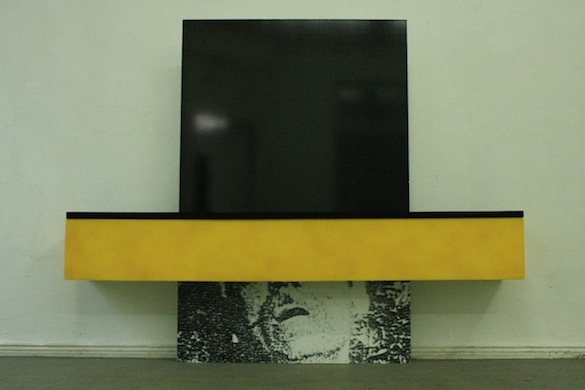
Steeve Bauras, Zugzwang n°3, 2011
Somewhere between Sculpture and Acoustic Experimentation
The varied range of operations illustrated by the arrangement is linked to the making-of and the processes inherent in sculpture and sound. Educated in Fort-de-France and then at the Paris School of Fine Arts in the sculptor Emmanuel Saulnier’s studio, Steeve Bauras owes this variety to an assiduous presence in the urban wildernesses of Europe, Africa and the Americas (Berlin, Krakow, Dakar, Montreal, Santiago de Chili) and an ongoing dialogue with the underground noise musical scene. In Small Local Abattoirs #3 we find the remnants of these daytime and nighttime crossings, like the block of black bricks to which the video projector is strapped, or the impressive speaker which, from the box occupied in the Centquatre stables, makes a rock underground vault.
The Strategy of the Forced Move
The traditional features of the white box, the picture rail and lighting are thwarted. The industrial recess is a crypt where, here, there and everywhere, the image slips, cuts, breaks, tears and disconcerts, encouraging the Zugzwang strategy. Under this title, the artist brings together a series of works produced since 2011, the title meaning: “forced move”. The ideal would have been not to play, for fear of degrading his position, but there is no option. “In my work”, explains Steeve Bauras, “ this word neatly translates the state in which I can find myself before any new project, somewhere between excitement and huge fright. More subtly, the Zugzwange are hypotheses which I put forward around photography with regard to its display methods and, above all, its weaknesses.”3 In order to exist, the photograph literally has to be exposed. Taking the risk of space. Producing its own light and its own areas of shadow. In fact the hoarse elegance of Small Local Abattoirs #3 diverts the photograph from the usual procedure of its display. Images are shown jerkily and intermittently. They rise up, like the tuning keys of an electric guitar or the face of an experimental rocker extricating himself from the night of the stage, by way of a light beam or a projector. The precision of the positioning of the segments, masses, lines and surfaces proceeds from a ground-wall marking by chromatic touches, compactness and reduction, saturation and entrenchment. Hypotheses where the move, played as a losing one, is in the end won.
Stimmung and Reading Climate
In the half-light of the Centquatre stables, the elements which form Small Local Abbatoirs#3 and vibrate in the glow of a hypnotic video are presented at the mercy of the distressing echoes of a macabre sound track.
The creation of an at once luminous and acoustic atmosphere where the objects stake out a terrain left fallow—delegating to the viewer the task of working out his/her own narrative, and making his/her own reconstruction of the plastic facts presented—is one of the keys for understanding the arrangement. When you ask Steeve Bauras about his installation praxis, he talks readily about Stimmung, about reading “climate”, about “ambience” and resonance.
The German idea of Stimmung—atmosphere, mood—which defines an emotional experience where imagination agrees with understanding, an “acoustics of the soul” for the romantics, has, over the course of time, known accepted meanings and diverse ramifications (in painting, aesthetics, poetry and music). It invariably describes a rhythmic disposition tinged with affect which, by drawing from the vocabulary of originally Black American popular music, we might translate by ‘groove’: the understanding of the flow and texture of a piece of music at the same time as the sensation produced by the dynamics of the piece.
As a vital pulsation, the groove (or swing of jazz) is that layer of subjectivity where harmonic fragments and rhythmic sections are unified; an indefinable “state” where everything is in its place, though without “suffering” from the tempo. A state of grace where stasis and speed are balanced. To each work its groove. To each place its tempo. Steeve Bauras’s small abattoir gives the exact measure of the Centquatre stables. Brick walls, metallic prints and the phasing of a perfectly calibrated musical accompaniment.
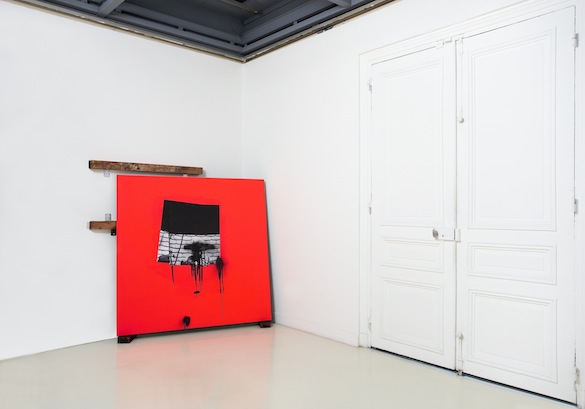
Steeve Bauras, Zugzwang n° 5, White dreams 1/2, © Photo Emba,Galerie Édouard Manet de Gennevilliers,
Photo Laurent Lecat 2011.
De-phasing
The phasing [or de-phasing] of the sound track conditions our understanding of the arrangement. A distant but persistent noise is reflected by the walls which at times makes us think of the movement of the double-pedal of a large drum. This discrepancy can be understood as the possibility of entering into the artist’s groove while savouring the dynamics of the work; pulsating climate of Stimmung or rhythmic affect.
Laboratory or Knacker’s Yard?
With Small Local Abattoirs #3 there is a strange semantic shift from stable to slaughterhouse. Morbid stud farm or grim knacker’s yard. The place is imagined on the basis of all its historical and plastic dimensions. The building housing the City of Paris Funeral Parlour was erected in 1873 where the slaughterhouse of the Commune de la Villette once stood. Well aware of this past, Steeve Bauras nevertheless offers a very personal explanation of his title: “Small Local Abattoirs #3 is this formal laboratory where things are simultaneously destroyed and constructed. It is also the strange way which, from exhibition to exhibition, projects have of killing each other off and neutralizing one another.”4 Between the lines, we find the principle of roaming—vagabondage—, or more exactly of reportage, which takes Steeve Bauras from German suburbs to noise concert halls, and enables him to renew his inspiration.
“Fieldwork” photography and iconic investigation lie at the heart of the muffled slaughter represented by Small Local Abattoirs #3. With the artist, the spectator moves through an event, experiencing its pressures and temperatures, from the heat of red lead to the cold of a matt metal. Nothing is left to chance in the way the situation is developed, with the creative process merging with a choral arrangement of the phenomena: sound, static image and video, minimal and powerful elements of sculpture, all exchange in an incisive and mordant snapshot.
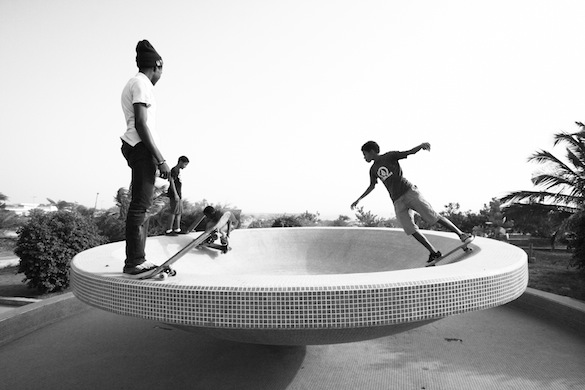
Steeve Bauras, 3K Project, 2013,
Photo, vidéo, son, sculpture. Galerie Le Manège, Sénégal.
1 Jeune Création at Centquatre, Paris, from 30 October to 2 November 2014.
2 As part of the group shows “Intimités” at SAVVY Contemporary, Berlin-Neukölln, from 9 to 29 June 2013 and “VOLTA”, Grace Exhibition Space, Brooklyn, from 6 to 9 March 2014.
3 Steeve Bauras, in an interview in April 2013 for the Association internationale des critiques d’art. Online on the Aica / Caraïbe du Sud site : “B-B, Zugzwang n°7, 2013, de Steeve Bauras à Berlin : No Milk Today [Kunsthalle HB55, 3-11 mai 2013].”
4 Steeve Bauras interviewed by the author, Paris, 8 November 2014.
articles liés
Biennale Son
par Guillaume Lasserre
Lou Masduraud
par Vanessa Morisset
Bharti Kher
par Sarah Matia Pasqualetti